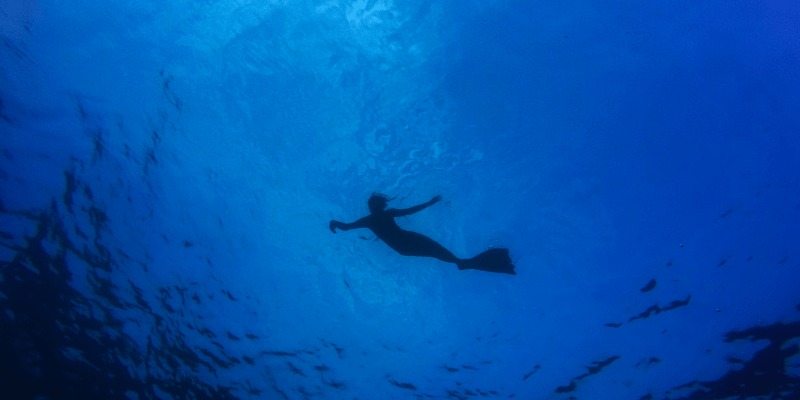
How to dive deeper than 2000 metres on one breath
By Tim Brown, Class of 2016
If a bag of money fell into the ocean, how deep would you dive for it? You don’t have SCUBA gear or any long poles with a hook on the end. All you have is one breath. But it’s a big bag of money.
Personally, the deepest I’ve reached on one breath is around 10 m. Given my current bank balance, I could probably push that out to 15 m. If you were William Trubridge, the money would still be attainable at 122 m. If you were an elephant seal, you’d already be thinking about what to spend the money on.
Despite being air-breathing mammals, just like us, elephant seals have reached depths as great as 2388 m. To get down this deep and come back up alive, they’ve had to overcome a number of serious challenges.

Challenge #1: Pressure
At 2000 m the pressure is around 200 times greater than the pressure at the surface. This isn’t a problem for solid body parts like bones and muscles. But for air-filled spaces, it is a different story. Under those pressures, our ears and sinuses would be destroyed and our lungs would completely collapse, snapping our ribs like twigs.
So why doesn’t this happen to elephant seals? Firstly, they don’t have any ears or sinuses that are filled with air. As for their lungs, they don’t have a rigid structure like our ribs and are completely compressible. Elephant seals exhale before they dive, leaving next to no air in their lungs. This has the added benefit of preventing “the bends”, which results from breathing air at depth.
But if they breathe out all their air BEFORE they dive, how do they hold their breath long enough to get down so far?
Challenge #2: Oxygen
This is arguably the greatest challenge. To get down to these depths you have to expend a lot of energy and hold your breath for a long time. Unfortunately, we just don’t have the bodies for this. We could train ourselves to dramatically drop our heart rate to conserve oxygen, as elephant seals do. But some things can’t be taught.
Elephant seals can carry three times as much oxygen per unit of body mass than humans. While most of our oxygen is our lungs, theirs is in the blood and muscle tissue. Oxygen is stored in muscles by a molecule called myoglobin. Elephant seal muscles have 8 times as much myoglobin as human muscles, and therefore, can store a lot more oxygen.
Speaking of globins, elephant seal blood is 33% richer in haemoglobin, allowing greater carrying capacity of oxygen. They also have a lot more blood. In fact, at 22%, elephant seals have the most blood per weight of any mammal (humans are 7% blood by weight).
Not only can elephant seals carry more oxygen, they can also use more of it. At the end of a dive, the oxygen concentration in their veins can drop below 5% of their maximum. For us, concentrations this low would cause extensive damage to our cells. While it is not fully understood how elephant seals cope with this, carbon monoxide may be the answer. Carbon monoxide is a killer at high concentrations, but may be a life saver in lower doses. At low levels, it can actually protect tissues from the effects of sustained periods of oxygen deprivation. It just so happens that the concentration of carbon monoxide in elephant seal blood is naturally 10 times higher than humans.

Challenge #3: Temperature
As you go deeper, the pressure rises, but the temperature drops. Well until you reach about 1000 m. Below this depth the temperature remains relatively constant, at about 4°C. Survival time in water this cold is generally very short for warm-blooded mammals. Without protective clothing, a human would lose consciousness within 20 minutes.
When elephant seals reach these extreme depths, they don’t immediately ascend. Perhaps unsurprisingly, they’re down there for a reason: to hunt for food. To hunt effectively at these depths, elephant seals must be able to combat the cold.
Blubber is the most important of their thermal protection. This thick layer of fatty tissue provides an insulating layer under the skin to minimise heat lost to the ocean. While all seals have a layer of blubber, elephant seals have the thickest (accounting for up to 50% of their weight).
They also have another trick to minimise heat loss. In exposed parts of their body, their arteries are meshed together with their veins. So when the warm blood in their arteries is flowing towards their extremities, the heat is transferred to the cooler blood returning in their veins, rather than the water surrounding these extremities. This is known as a countercurrent heat exchange.
Records are meant to be broken
When an elephant seal (using all these adaptations) was recorded at a depth of 2,388 m in 2010, it became the deepest diving mammal known to man. In 2014, an elusive species of whale stole its thunder. A Cuvier’s beaked whale smashed the seal’s record, reaching 2,992 m.
A few interesting links:
http://mentalfloss.com/article/73596/14-huge-facts-about-elephant-seals
http://www.abc.net.au/news/2015-08-05/elusive-cuviers-beaked-whale-carcass-found-on-remote-beach/6674028